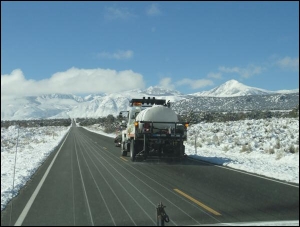Caltrans press release
Bishop – The California Department of Transportation (Caltrans) advises motorists that experts are predicting a slight increase in all methods of travel nationwide, with about 47 million people traveling either by car or airplane for the Thanksgiving holiday.
In anticipation of holiday travel, and the predicted El Niño to deliver adverse weather to the Eastern Sierra throughout this winter, Caltrans’ maintenance crews and mechanics have been busy preparing roadways for winter.
To prepare for snow and ice on the roadways in the upper elevations, Caltrans has applied a brine solution which helps the snow to melt quickly and reduces the chance of ice forming on the pavement. Throughout the district, culverts have been cleaned and drains have been cleared, so that excess water is diverted from the road and flows into appropriate basins. In addition, crews have replaced signs, refreshed striping and placed erosion control measures in preparation of a wet winter. While careful planning and evaluation is taking place across the state, the weather impact on the drought-stricken terrain cannot be predicted.
Maintenance crews have been out in force and Caltrans’ mechanics have been focused on preparing winter equipment for the challenge ahead. Caltrans has been preparing for snow and heavy rain by positioning equipment, materials and increasing staffing levels in regions most likely to experience extreme weather.
Caltrans has closed three mountain passes in District 9 for the season: Sonora Pass/State Route 108, Monitor Pass/State Route 89 and in conjunction with Yosemite National Park, Tioga Pass/State Route 120 west, and all are not scheduled to reopen until the spring.
Follow Caltrans District 9 on Facebook at www.facebook.com/California-Department-of-Transportation-District-9 and Twitter at @Caltrans9 and visit the Caltrans QuickMap at http://quickmap.dot.ca.gov for current traffic conditions.
Caltrans and the California Department of Highway Patrol (CHP) want you to get where you’re going safely this winter. The following are some driving tips that will help you prepare for winter driving conditions:
· Winterize your car – Check your brakes, windshield wipers, exhaust system and heater/defroster to make sure they are in good working condition. Check your radiator fluid level and add antifreeze/coolant as needed. Replace wiper blades if needed. Add a winter formula windshield wiper fluid. Make sure your tires are properly inflated and the tread is in good condition
· Check road conditions frequently –During Storms, call 1-800 ROAD (7623) or check the internet at http://quickmap.dot.ca.gov
· Carry in your car – a flashlight with extra batteries, blanket, extra clothing, water and snacks, towel, gloves, ice scraper/deicer, shovel, small broom, spare key, sand/kitty litter.
· Allow enough time – Slow down.
· Don’t panic – If you begin to slide while driving on snow or ice, slowly take your foot off the gas pedal and steer your vehicle in the direction you wish to travel. If you must use brakes and your vehicle is equipped with anti-lock brakes (ABS), apply firm steady pressure. If you do not have ABS brakes gently pump the brake pedal. Do not allow the brakes to lock up.
· Black Ice –Black ice is nearly invisible. The temperature doesn’t have to be below freezing in order for ice to form on road surfaces. Ice can form, especially when it’s windy, when the air temperature drops below 40 degrees. Low or shaded areas surrounded by landscaping or with a nearby source of water, such as bridges and underpasses, can have icy spots.
· Be observant – Do not pass snow removal equipment unless the operator directs you to.
· Stay with your vehicle – If you become stranded stay with your vehicle. Conserve fuel while maintaining warmth and be aware of possible exhaust or carbon monoxide problems.
· Chains – All vehicles, including those with four-wheel drive and snow tires are required to carry chains when traveling in areas that have chain control. Make sure they are the correct size for your tires and in proper working order.
Chains must be installed on drive wheels. Know if your vehicle has front or rear wheel drive. Cable chains are acceptable, but may not provide as much traction as traditional chains.
When chains are required the posted speed limit for all vehicles is reduced to 25, 30, or 35 MPH as posted. When installing or removing chains, pull completely out of the live lanes of traffic.
Chain installers may be available to help install your chains. Chain installers are independent business people, not Caltrans employees, who are permitted to install chains. If you choose to use their services you may ask for a receipt that includes the installer’s vest number. Chain installers are not allowed to sell or rent chains.

















